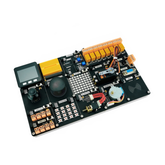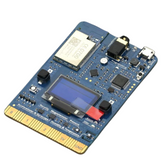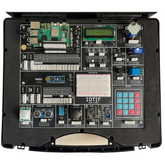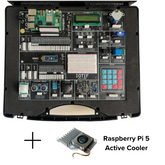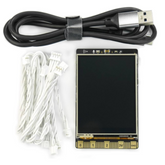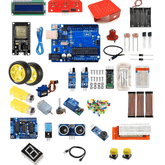Building an IoT Architecture
Summary
Discover the intricacies of building an IoT Architecture in our latest blog! From demystifying the concept of IoT to delving into its architecture, we've got you covered. Learn about the essential components that form the backbone of any IoT system. Dive deep into the four crucial stages of crafting a robust IoT architecture, from planning to implementation. Ready to revolutionize your understanding of IoT? Read on and embark on a journey towards creating cutting-edge solutions. Don't miss out on unlocking the potential of the Internet of Things!
Introduction
Have you ever been interested in the Internet of Things? You know the craze that's everywhere nowadays? Well, get ready, because we're about to go deep into it!
Together, we will solve the puzzles around IoT architecture in this blog. We'll cover everything, from understanding the fundamentals to exploring the minor points. So, get comfortable, grab your favorite beverage, and come along with me as we build an IoT architecture. I promise it will be entertaining and educational.
What is IoT?
The Internet of Things (IoT) describes the connection of everyday physical objects to the Internet which enables them to store and share data.

These items, which are often referred to as "smart" devices, can be anything from wearable technology and domestic appliances to industrial gear and environmental sensors.
Sensors, processors, and communication hardware are features that every Internet of Things device has, allowing it to collect data and exchange it with other devices or central systems via the Internet.
By allowing smooth communication and data sharing between objects and systems, the Internet of Things aims to enable more automation, efficiency, and convenience in various sectors of daily life, industry, and infrastructure.
What is IoT Architecture?
The Internet of Things (IoT) architecture is a complex structure that combines several interconnected elements, such as stages, sensors, actuators, cloud services, and communication protocols.
This complex structure is divided into stages to better manage data flow and maintain system integrity. At its heart, IoT design enables sensors to seamlessly collect data from a variety of devices and environments.

This data is then transferred over a network infrastructure, which uses both wired and wireless communication protocols. After being received, the data is processed, examined, and stored on servers in the cloud. Here, advanced algorithms are used to extract insightful information. These insights improve efficiency and user experiences by driving automation and decision-making processes.
The architecture of the Internet of Things is changing along with the industry to meet new developments in sensor technology, communication protocols, and cloud services. This allows the IoT to be used in more industries and domains and has more potential applications.
Components of IoT Architecture:

Devices:
Equipped with sensors to gather data, examples include Temperature sensors in smart thermostats like Nest or Ecobee. Smoke detectors like the Nest Protect. Surveillance cameras and CCTVs.
Actuators:
Devices that execute actions based on preprogrammed tasks, such as Smart lights like Philips Hue or LIFX bulbs. Smart locks such as August Smart Lock or Schlage Connect. Thermostats like Nest Learning Thermostat or ecobee SmartThermostat.
Gateways:
Entry and exit points within a network facilitating data movement between devices and the network. Examples include Routers and switches managing network traffic in a smart home setup. Zigbee or Z-Wave hubs like Samsung SmartThings or Hubitat Elevation.
Cloud Gateways:
Specialized gateways for data compression and entry from field gateways to the cloud. Examples include Microsoft Azure IoT Edge and AWS IoT Greengrass.
Data Lake:
Storage space for structured and unstructured data generated by IoT devices. Data is filtered and cleaned before sending to a data warehouse. Examples include Amazon S3 for storing raw sensor data. Google Cloud Storage for archiving IoT device logs and media files.
Data Warehouse:
Stores cleaned, filtered, and structured data from the data lake for further analysis and use. Examples include Google BigQuery for analyzing structured IoT data. Snowflake Data Warehouse for storing and querying IoT telemetry data.
Data Analytics:
Practice of finding trends and patterns within the data warehouse to gain actionable insights and make data-driven decisions. Tableau for visualizing trends in energy usage data from IoT devices. Microsoft Power BI for analyzing customer behavior patterns from IoT sensor data.
User Applications:
Software components (e.g., smartphone apps) allowing users to control IoT network functionality, send commands, and access features. Mobile apps like the Nest app for adjusting thermostat settings remotely. Web portals are provided by security camera manufacturers for viewing live footage and managing recording schedules.
Machine Learning:
Enables the creation of precise and efficient models for control applications by identifying patterns and predicting future outcomes based on historical data stored in the data warehouse. Examples include Predictive maintenance models analyzing equipment sensor data to forecast maintenance needs. Anomaly detection algorithms identify unusual patterns in energy consumption data to detect potential faults or inefficiencies.
Four Main Stages of Building IoT Architecture

Perception:
Sensors and actuators are set up in the first first stage to collect data from the objects. Actuators can take action based on the data received, such as changing settings or starting actions, while sensors record different factors including temperature, pressure, motion, or chemical composition. This stage includes a broad range of equipment, such as robotic systems, environmental monitors, and industrial sensors. At this point, data processing is limited by the capabilities of each IoT device, thus it is appropriate for urgent data requirements.
Network:
The second stage involves gathering sensor data and converting it into a digital format for further processing. The gateways to the internet act as a bridge between downstream systems and sensor networks. Once the data has been digitalized, these gateways send it to third stage systems over a variety of networks, including LANs, the Internet, and Wi-Fi. Here, preprocessing of the data takes place to effectively handle the high volume and transform analog data into digital streams. Also, intelligent gateways may include extra features like analytics and security controls.
Processing:
Before the digitalized and aggregated data enters the cloud or central data center, the third stage of processing is required. Edge IT solutions reduce the load on central IT infrastructure and network bandwidth by putting analytics and processing closer to the sensors. Real-time anomaly identification and data visualization can be achieved through the use of machine learning techniques and visualization tools. These systems are frequently installed in wiring closets, distant offices, and other peripheral places.
Application:
Data that needs to be processed thoroughly or examined more deeply, and for which receiving a response right away is not essential, is sent to the fourth stage systems that are stored in data centers or on cloud-based platforms. These systems can handle and safely protect the data since they have more processing power and storage capacity to carry out complex analyses.
In this stage, it is usual practice to combine sensor data with other data sources to provide comprehensive insights. Depending on particular needs and constraints, processing can take place on-site, in the cloud, or through hybrid cloud configurations.
Conclusion:
Major developments in automation and productivity are being driven by IoT architecture, which provides the foundation for the smooth integration and data flow between physical objects, sensors, actuators, and cloud-based systems in a variety of industries. It includes a complete structure made up of devices with sensors, actuators, gateways, cloud services, and advanced data processing parts.
IoT design enables real-time analytics, perceptive data visualization, and predictive modeling spanning four critical stages: perception, network, processing, and application. This allows for proactive interventions and well-informed decision-making. The architecture of the Internet of Things is flexible and adapts to new use cases and emerging technologies as the industry develops, pointing to a future of more connection, intelligent automation, and improved user experiences.



